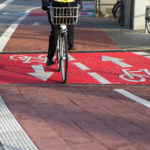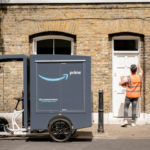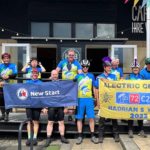I remember my Dad fitting a dynamo to my bike to power the lights. Friction driven on the rear tyre. The faster the wheel rotation the brighter the lights! My curiosity is: why don't electric bikes have a battery charging facility so that when you are not using the motor and able to freewheel down hills some power is put back into the battery? I still think back to my Dad's car driving lessons with me. On any decent, long hill it was always to put the gears into neutral, turn the ignition off and freewheel to save petrol! Restart the car in fourth gear at the end of the hill! Chuckle, that was in 1960. No steering wheel lock, no power steering, no servo brakes in those days and not many cars! But I digress . . .
Intrigued!
- Thread starter verntern
- Start date
Essentially it doesn't work too well on e-bikes since skilled riders don't do much hard braking as it wastes inputted energy, and downhill the natural runaway speed of a bike can be used for the kinetic energy to propel it up the hill the other side or further along the following flat. Doing that uses all the stored energy, but converting it via the hub motor braking into electricity involves an efficiency loss. Equally, when that generated electricity is converted by the motor into mechanical energy later, there's a further efficiency loss. So in essence it's more a marketing gimmick rather than a sensible way of using a bike's kinetic energy. In addition, regen means the hub motor has no freewheel, so pedalling without power has to overcome the drag of turning the dead motor.
However, the BionX motor has a switched regeneration position for use downhills and the original "Motorised Wheel" made by the Birkestrand Corporation had regen too. The latter became the Sanyo hub motor later and Giant used it on their Twist 1 and Twist 2 bikes with regen, but they were not successful since the motor drag lost more energy than the regen gave back. Therefore they dropped the regen, put in a motor freewheel and relaunched as the Freedom model, much better.
Despite all this, Panasonic have produced a regenerating brake front hub motor and 3000 bikes with them are being sold in Japan for a couple of years trialling. We may yet see them here.
.
However, the BionX motor has a switched regeneration position for use downhills and the original "Motorised Wheel" made by the Birkestrand Corporation had regen too. The latter became the Sanyo hub motor later and Giant used it on their Twist 1 and Twist 2 bikes with regen, but they were not successful since the motor drag lost more energy than the regen gave back. Therefore they dropped the regen, put in a motor freewheel and relaunched as the Freedom model, much better.
Despite all this, Panasonic have produced a regenerating brake front hub motor and 3000 bikes with them are being sold in Japan for a couple of years trialling. We may yet see them here.
.
Last edited:
This has always intruiged me also.
Bottom line is that you cannot create energy, only convert it. Going back to basic pyhsics, if you had a device that converted kinetic energy of the wheel moving, some energy would be lost through friction, sound and heat. Therefor it wouldn't be worthwhile.
Regen braking works as it only works whilst braking, which is when you are loosing the kinetic energy anyway.
If you had a dynamo system built in to recharge the battery, it would create so much resistance that it would have an adverse affect on your input.
What you could do though, is mount a hamster in a wheel on your pannier, use his kinetic energy and get the little nlighter to run all day whilst you ride, then harness his energy to recharge the battery.
Genius.
Bottom line is that you cannot create energy, only convert it. Going back to basic pyhsics, if you had a device that converted kinetic energy of the wheel moving, some energy would be lost through friction, sound and heat. Therefor it wouldn't be worthwhile.
Regen braking works as it only works whilst braking, which is when you are loosing the kinetic energy anyway.
If you had a dynamo system built in to recharge the battery, it would create so much resistance that it would have an adverse affect on your input.
What you could do though, is mount a hamster in a wheel on your pannier, use his kinetic energy and get the little nlighter to run all day whilst you ride, then harness his energy to recharge the battery.
Genius.
Photo voltaic cells on the panniers / rack ?
Dont tell me - already debated and not worth doing!
Is there a new law of physics applicable to this forum - ideas can be neither created nor destroyed, just recycled with some energy lost to heat ?!!
Coat already on!
Byeee
Bob_about
Dont tell me - already debated and not worth doing!
Is there a new law of physics applicable to this forum - ideas can be neither created nor destroyed, just recycled with some energy lost to heat ?!!
Coat already on!
Byeee
Bob_about
Photo voltaic cells on the panniers / rack ?
Dont tell me - already debated and not worth doing!
Is there a new law of physics applicable to this forum - ideas can be neither created nor destroyed, just recycled with some energy lost to heat ?!!
Coat already on!
Byeee
Bob_about
No, the core trouble is specified in my answer here on another thread.
Photo voltaics have worked to a very limited extent on bikes, and to somewhat better effect on ultra light "cars" that are more like velomobiles, but only in flat and very sunny territory like much of Australia.
I don't think we have debated the direct use for bikes, no doubt a dead end in the UK, but we have explored using photo-voltaics for battery charging and some members use it in conjunction with caravanning etc.
.
There are a number of PV powered light about now, such as Evans Cycles | Cateye EL020 Solar/Battery Hybrid Front Light | Online Bike Shop. Not sure how well they work in practice though.Photo voltaic cells on the panniers / rack ?
Dont tell me - already debated and not worth doing!
Is there a new law of physics applicable to this forum - ideas can be neither created nor destroyed, just recycled with some energy lost to heat ?!!
Coat already on!
Byeee
Bob_about
You could put energy back into the system if the downhill after climbing a hill was steep enough that you had to use brakes to keep to a safe speed, presumably.
Instead of discarding the kinetic energy as heat via the brakes, the regenerating gear would convert it back into usable energy whilst acting as a brake.
The only flaw with this is that such hills followed by steep downhills do not occur often in the real world.
As soon as I have 6 days free, I will create a new world to facilitate use of regenerative power
Instead of discarding the kinetic energy as heat via the brakes, the regenerating gear would convert it back into usable energy whilst acting as a brake.
The only flaw with this is that such hills followed by steep downhills do not occur often in the real world.
As soon as I have 6 days free, I will create a new world to facilitate use of regenerative power
Only wimps use brakes - I consider mach1 to be reasonably safe on a bicycle; anything faster and the tyres may melt.You could put energy back into the system if the downhill after climbing a hill was steep enough that you had to use brakes to keep to a safe speed, presumably.
Colin
Related Articles
-
 MTF Enterprises announces acquisition of EMU Electric Bikes
MTF Enterprises announces acquisition of EMU Electric Bikes- Started by: Pedelecs
-
 Wisper 806T folding bike wins Which? ‘Best Buy’
Wisper 806T folding bike wins Which? ‘Best Buy’- Started by: Pedelecs
-
 Sustrans calls for protected cycle lanes
Sustrans calls for protected cycle lanes- Started by: Pedelecs
-
 Amazon launch their first UK e-cargo micromobility hub
Amazon launch their first UK e-cargo micromobility hub- Started by: Pedelecs


